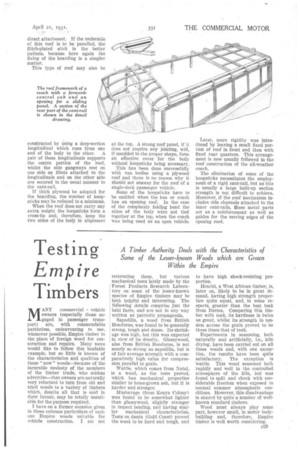Testing Empire Timbers
Page 51

If you've noticed an error in this article please click here to report it so we can fix it.
A Timber Authority Deals with the Characteristics of Some of the Lesser-known Woods which are Grown Within the Empire MANY commercial vehicle owners (especially those engaged in passenger transport) are, with commendable patriotism, endeavouring to use, whenever possible, Empire timber in the place of foreign wood for construction and repairs. Many more would like to follow this laudable example, but so little is known of the characteristics and qualities of these " new " woods—because of the incurable modesty of the members of the timber trade, who seldom advertise—that owners are naturally very reluctant to turn from old and tried woods to a variety of timbers which, despite all that is said in their favour, may be totally unsuitable for the purpose required.
I have on a former occasion given in these columns particulars of various Empire woods suitable for vehicle construction. I am not
reiterating them, but various mechanical tests lately made by the Forest Products Research Laboratory on some of the lesser-known species of Empire timbers may be both helpful and interesting. The following details comprise just the bald facts, and are not in any way written as patriotic propaganda.
Sapodilla, a wood from British Honduras, was found to be generally strong, tough and dense. Its shrinkage was high, but this was expected in view of its density. Glassywood, also from British Honduras, is not nearly so strong as sapodilla, but is of fair average strength with a comparatively high value for compression parallel to grain.
Wattle, which comes from Natal, is a wood, as the tests proved, which has mechanical properties similar to home-grown ash, but it is harder and stronger.
Musharage (from Kenya Colony) was found to be somewhat lighter than glassywood, slightly stronger in impact bending, and having similar mechanical characteristics. Tests on danta (Gold Coast) proved the wood to be hard and tough, and to have high shock-resisting properties.
Hendul, a West African timber, is, later on, likely to be in great demand, having high strength properties quite equal, and, in some respects, greater than the best teak from Burma. Comparing this timber with teak, its hardness is twice as great, whilst its strength in tension across the grain proved to be three times that of teak.
Experiments in seasoning, both naturally and artificially, i.e., kiln drying, have been carried out on all these woods and, with one exception, the results have been quite satisfactory. The exception is Wattle. This wood seasoned both rapidly and well in the controlled atmosphere of the kiln' but was found to split and check with considerable freedom when exposed to normal summer atmospheric conditions. However, this disadvantage is shared by quite a number of
well known standard timbers.
Wood must always play some part, however small, in motor bodybuilding and, therefore, Empire timber is well worth considering.












































































































